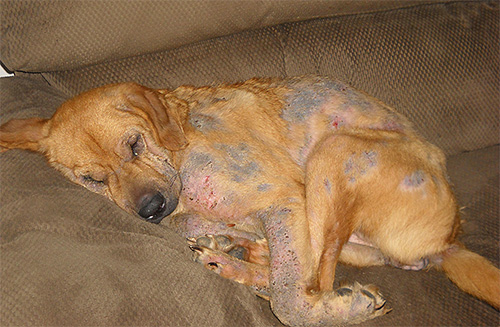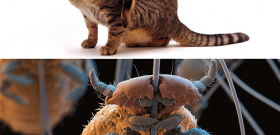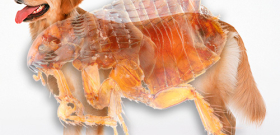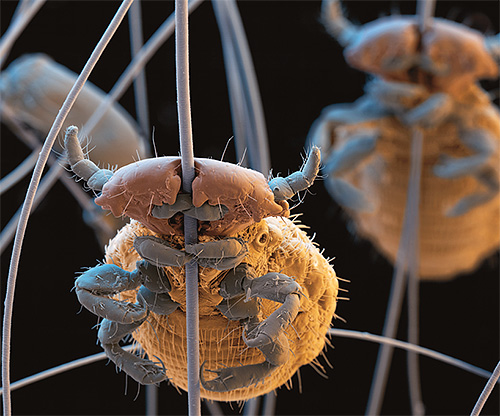
Let's start with the fact that lice in dogs do exist - this is a scientific fact. Moreover, they torment a four-legged friend no less than human lice of people. Like humans, lice in dogs are of several different types, differing from each other in biology and body structure:
- the actual dog louse (Linognathus setosus) is a small yellow-gray parasite that causes constant anxiety of the animal, scratching the skin, and in case of severe infection, the pet's emaciation;
- Canine Vlasie (Trichodectes canis) - has about the same size as a louse, but when infected causes hair loss, dermatitis and constant itching.
The photographs below show a dog louse and a lice eater:

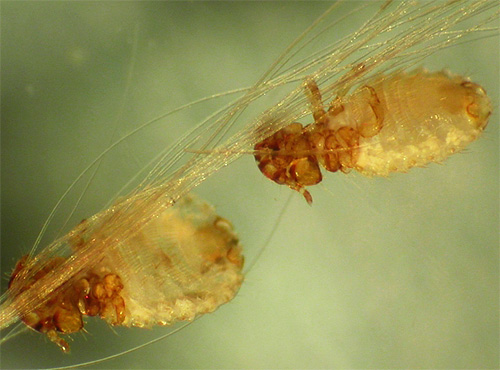
It is very easy to confuse these two parasites, but there will be no trouble in this, since the fight against them is approximately the same. The main thing here is to be able to detect them on the dog even before serious consequences occur.
In addition to the fact that these parasites cause damage to the coat and dermatitis, they also carry very dangerous helminths, and are quite common in dogs. Therefore, it will be useful for the owner of a dog of any breed to know what lice and lice look like in dogs, as well as how to quickly remove them from a pet.
The photo shows typical signs of dermatitis in a dog:

On a note
Infection of a dog with lice is called syphunculosis.
Lifestyle and appearance of lice in dogs
Lice in dogs look like very small insects of a yellowish gray or light gray color with an elongated body.Lice from withers are difficult to distinguish, and such differences can be noticed only with due experience and careful examination of parasites:
- the louse has a long, elongated and narrow body, while the louse has a dense and wide body
- the lice have a large semi-square head, while the louse has a much narrower head.
These signs are clearly visible if you hold a live adult insect on your hand.
This is how, for example, lice in dogs look like (close-up photo):
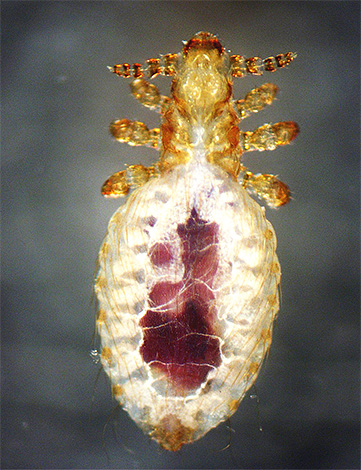
And the following photo shows the lice:
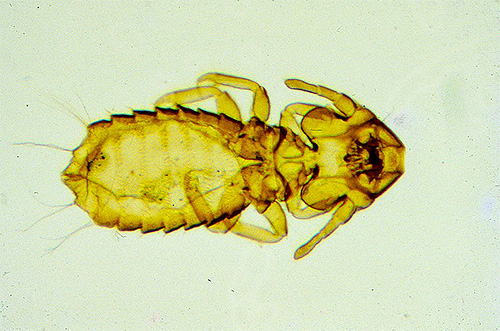
There are differences in the way of life of lice and withers. Dog lice feed on the blood of an animal - their mouthparts are adapted only for piercing the skin and sucking blood. Vlas-eaters, on the other hand, feed mainly on exfoliating skin, hair, and secretions from the skin glands of the animal.
Lice differ from fleas by their light body and inability to jump. In addition, the louse is easily crushed between the fingers, while crushing the flea is extremely difficult due to its very strong chitinous shell.
Photo of a flea: This jumping parasite is really difficult to confuse with lice or withers.
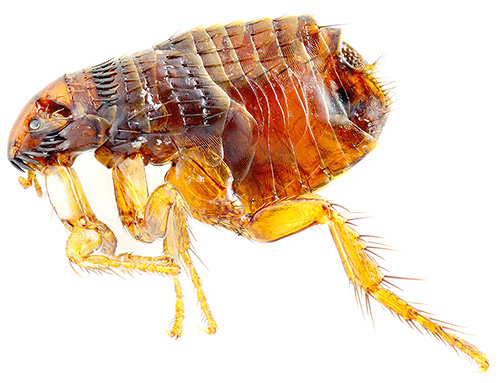
Dog lice cannot infect other animals - they are strictly specific to one host species, and can only parasitize dogs. This means that a person or a cat cannot get lice from a dog.
Dog lice reproduce by sticking their eggs to hairs. The sticky shell of the egg quickly hardens in the air, and it is very difficult to remove all such a structure from the wool.
An egg with a shell is called a nit, after the example of human lice. Nits are very resistant to adverse environmental factors and even tolerate the treatment of animal hair with many modern insecticides.
And further: A selection of effective remedies for lice and nits (the article has more than 100 comments)

On a note
With a large number of lice, they cause the hairs of the dog's hair to stick together, as a result of which tangles are formed. This is especially true for long-haired breeds: parasites in their coat may not be noticeable, but the appearance of matted hair is a good diagnostic sign of the presence of insects.
Lice in dogs with a slight infection does not strike the eye, but in pets of dark breeds, even at the initial stages of infection, they are usually easy to notice: the lice themselves and their nits look lighter against the background of dark wool.
Vlice eaters are more common in dogs than lice, but in general both parasites are much less common than fleas.
Why are lice dangerous for dogs?
The danger of lice in dogs lies primarily in the fact that they cause constant itching with their bites. The same is true for lice eaters - although they do not bite directly, they constantly scrape the skin and can gnaw through it to sensitive layers.
The consequences of a severe lice infestation in dogs can be:
- hair loss, baldness and general deterioration of the coat (see photo)

- allergy to stings
- dermatitis developing in places of constant scratching, eczema and neurodermatitis

- anemia with a large number of daily bites
- dog weight loss and exhaustion
- infection with helminths, in particular - cucumber tapeworm.
Especially dangerous are lice in puppies: in babies, when infected, growth retardation, a weakened immune system, and constant depression may appear. That is why if the dog has lice, they need to be removed as soon as possible.
How do dogs get lice?
In most cases, lice are transmitted from a sick animal to a healthy one through close contact - playing, sleeping, mating, in a fight.
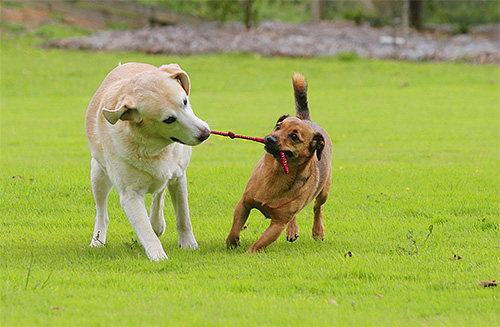
It is very difficult to avoid such contacts, and even a fairly well-groomed domestic dog can be infected - as long as its owner has not noticed the parasites.
Often, the owners themselves infect their pets by bringing hair from other animals from the street or from guests on their clothes. When infected with lice, the dog loses individual hairs especially intensively, and therefore, with a high probability, such hairs with insects or their eggs will fall on the clothes of the person who stroked the animal.
Treating a dog for lice
Getting lice out of a dog is generally easy. Since neither lice nor lice, unlike fleas, can escape from an animal, they will die when treated with any effective insecticidal preparation.
And further: Secrets of getting rid of lice and nits on your own (the article has more than 300 comments)
Treatment of lice in dogs can be carried out by the following means:
- Insectoacaricidal drops on the withers - these products are suitable for all breeds of dogs, and some even for puppies. Drops Stronghold, Frontline, Hartz, Bars are especially known. In the line of each manufacturer there are preparations for dogs of different breeds and ages, so choosing the most suitable drops is not difficult. You need to apply them like this: from a pipette, liquid is dripped onto the withers at the back of the dog's head (some drugs - in several places along the spine) and carefully rubbed into the skin. After that, through the network of subcutaneous blood vessels, the insecticide spreads throughout the body and poisons parasites that suck the blood or feed on the skin of the animal.Drops are the easiest to use means that retain their effect for a long time. Only sometimes they can cause an allergy in an animal.

- Sprays, many of which are suitable even for puppies. These remedies are good because they rarely cause allergies, but have only a small residual effect. To remove lice with their help, it is necessary to treat the entire coat of the dog as completely as possible with a spray, withstand the drug for several hours and rinse. Lice in a puppy can be destroyed with Frontline and Hartz sprays - these remedies, even with some contact with the digestive tract, do not lead to side effects. In adult dogs, Bars, Blochnet and Advantage sprays can also be used.

- Insecticidal shampoos - these are most suitable for puppies and toy breed dogs. The most famous among dog breeders are RolfClub, Fitoelita and Lugovoi. Shampoo is simply applied to wet hair, lathers, aged for 15-20 minutes and washed off. Shampoos are mostly non-allergenic, act quickly, but are quite expensive and difficult to treat large dogs.

Sometimes flea collars are recommended for lice and lice in dogs. Indeed, collars will allow you to remove lice within one to two weeks, but they often cause allergies and damage to the coat at the place of wearing. It is rational to use collars for dogs that constantly live outdoors as a prevention of infestation with lice and fleas.
Flea collar photo:
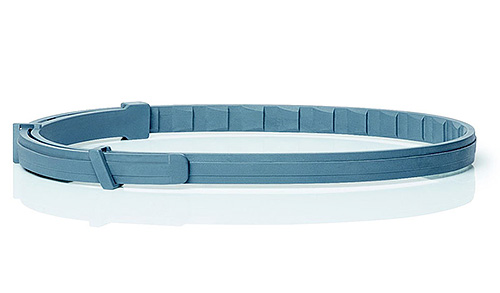
After removing lice from a dog, be sure to pickle the worms.
Safety and Precautions for Lice Removal
When using any remedy for lice, you should be aware of contraindications and possible side effects.
Most products should not be used for pregnant and lactating dogs, puppies under the age of one month and dogs weakened by diseases - infectious or somatic.

In these situations, you should always choose a specialized drug.
However, in any case, both pregnant and puppies, and sick dogs should be rid of lice, since these parasites can aggravate any health problems in the animal. It is wise to seek the advice of a veterinarian in such situations.
In order to protect your pet from infestation with lice (and other parasites), you should ensure that the dog does not communicate with stray animals. It is useful to wear a flea collar on the animal while walking. And the owners themselves, after returning from guests who have animals, or from long walks on the street with neighbors' pets, should, without entering the house, clean their clothes with a thick brush. Such measures will be quite enough to ensure that your dog will never know what lice and lice are.
20 most important facts about lice that everyone needs to know
Useful video: how to properly treat a dog with an insecticide

